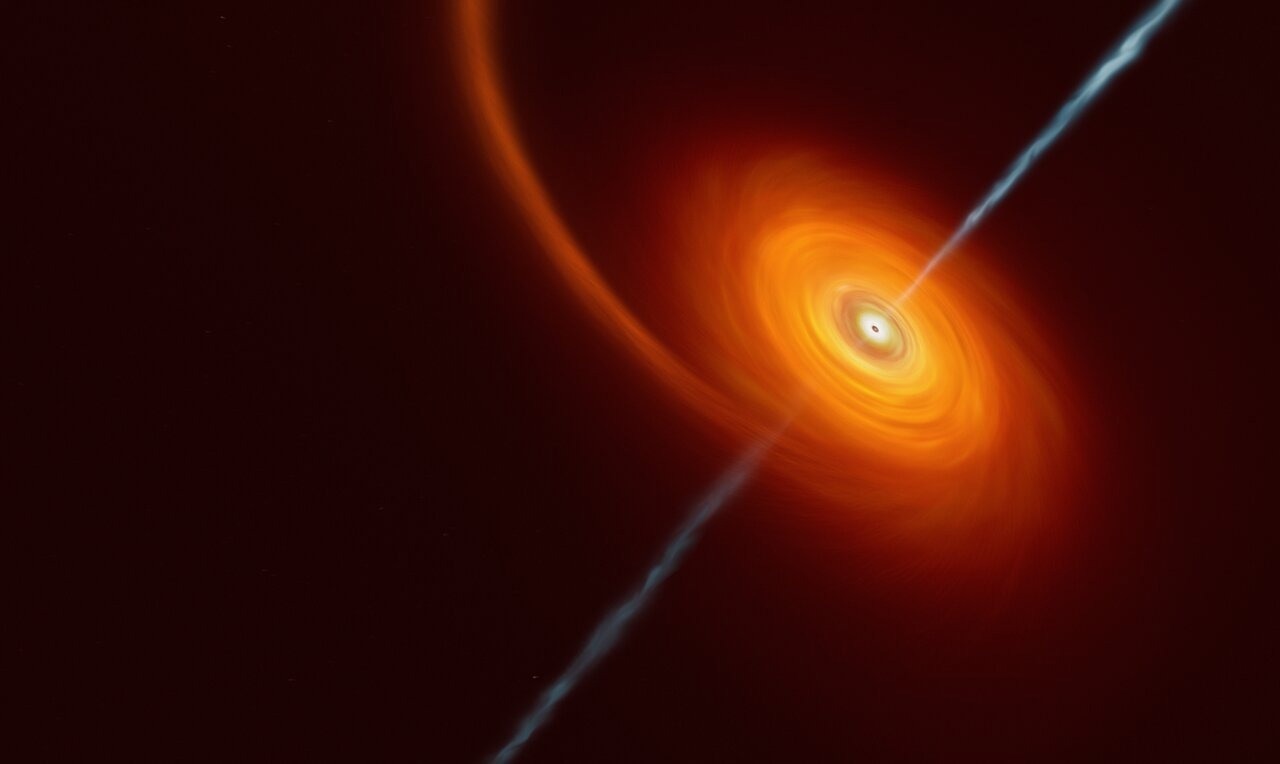The European Southern Observatory’s Very Large Telescope (ESO’s VLT) received an alert earlier this year concerning an uncommon source of visible light that had been spotted by a survey telescope.

This artist’s impression illustrates how it might look when a star approaches too close to a black hole, where the star is squeezed by the intense gravitational pull of the black hole. Some of the star’s material gets pulled in and swirls around the black hole forming the disc that can be seen in this image. In rare cases, such as this one, jets of matter and radiation are shot out from the poles of the black hole. In the case of the AT2022cmc event, evidence of the jets was detected by various telescopes including the VLT, which determined this was the most distant example of such an event. Image Credit: ESO/M.Kornmesser.
The VLT, along with other telescopes, was quickly shifted to aim at the source: a supermassive black hole in a faraway galaxy that had consumed a star, ejecting the remains in a jet.
The VLT established that this was the furthest instance of such an event to have ever been viewed. As the jet is pointing nearly directly at us, this is also the first time it has been spotted with visible light, offering a new way of identifying these rare events.
Stars that roam very close to a black hole are frayed apart by the phenomenal tidal forces of the black hole in what is called a tidal disruption event (TDE). Around 1% of these result in jets of plasma and radiation that are expelled from the poles of the rotating black hole.
In 1971, John Wheeler, the black hole pioneer, presented the concept of jetted-TDEs as “a tube of toothpaste gripped tight about its middle,” causing the system to “squirt matter out of both ends.”
We have only seen a handful of these jetted-TDEs and they remain very exotic and poorly understood events.
Nial Tanvir, Study Researcher, University of Leicester
Nial Tanvir guided the observations to establish the object’s distance with the VLT.
Astronomers are therefore continually looking for these rare events to comprehend how the jets are actually formed and why such a small portion of TDEs create them.
As part of this hunt, a number of telescopes, including the Zwicky Transient Facility (ZTF) in the US, frequently scan the sky for indications of short-lived, frequently extreme events that could then be explored in a much in-depth manner by telescopes like ESO’s VLT in Chile.
“We developed an open-source data pipeline to store and mine important information from the ZTF survey and alert us about atypical events in real-time,” explains Igor Andreoni, an astronomer at the University of Maryland in the US who co-led the study reported recently in the journal Nature along with Michael Coughlin from the University of Minnesota.
In February 2022, the ZTF spotted a new source of visible light. The event, labeled AT2022cmc, was evocative of a gamma-ray burst—the most intense source of light in the Universe. The chance of observing this rare occurrence encouraged astronomers to reposition many telescopes worldwide to observe the rare source in more detail.
This included ESO’s VLT, which rapidly detected this new event with the X-shooter instrument. The VLT data pinpointed the source at an extraordinary distance for these events: the light generated from AT2022cmc commenced its journey when the universe was approximately one-third of its present age.
A wide range of light, spanning from high-energy gamma rays to radio waves, was collected by 21 telescopes worldwide. The researchers compared these data with various kinds of identified events, from kilonovae to collapsing stars. But the only setting that corresponded to the data was an uncommon jetted-TDE pointing toward us.
Giorgos Leloudas, an astronomer at DTU Space in Denmark and co-author of this study, explains that “because the relativistic jet is pointing at us, it makes the event much brighter than it would otherwise appear, and visible over a broader span of the electromagnetic spectrum.”
The VLT distance measurement discovered AT2022cmc to be the farthest TDE to have ever been detected, and this is not the only record-breaking feature of this phenomenon.
Until now, the small number of jetted-TDEs that are known were initially detected using high energy gamma-ray and X-ray telescopes, but this was the first discovery of one during an optical survey.
Daniel Perley, Study Co-Author and Astronomer, Liverpool John Moores University
This shows a new method of identifying jetted-TDEs, allowing additional research of these uncommon events and the exploration of extreme environments close to black holes.
Animation of a black hole swallowing a star
This animation is an artist’s impression of how the material of a star fell towards the black hole at the center of a distant galaxy, producing jets of matter and radiation. Because the jets are pointing almost towards us, the event, called AT2022cmc, could be discovered from Earth with an optical telescope for the first time. Video Credit: ESO/M.Kornmesser.
Journal Reference
Andreoni, I., et al. (2022) A very luminous jet from the disruption of a star by a massive black hole. Nature. doi.org/10.1038/s41586-022-05465-8